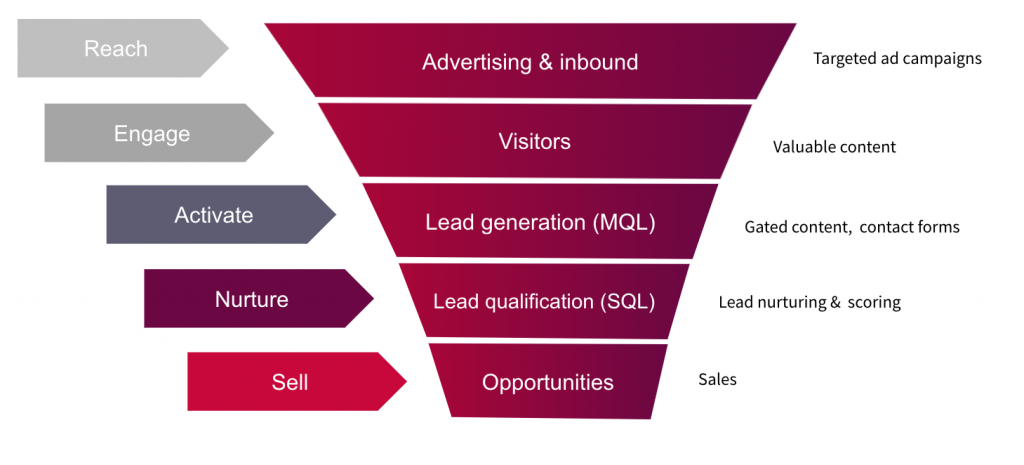Blog
13/10/2021
Automated lead management creates transparency and yields results
Automated lead management is not just about a process or a tool. It is marketing and sales alignment for effective lead management and conversion.
Before automated lead management, leads were collected from various channels such as trade shows, events and campaigns, then written down into an Excel sheet and stored on one’s own computer. Or if the lead was sent by email, the email was then forwarded to the right person. In essence, the leads were processed and contacted without anyone storing the information in any centralised system. This meant that it was hard for marketing or sales to gain visibility into the lead funnel or the results.
Automated lead management means that the customer’s contact request through a web form is processed and stored into a marketing automation system or customer relationship management system, more commonly known as CRM. After this, it is possible to nurture the lead and eventually pass it to sales if the lead meets the right criteria.
“Marketing and sales units still often work quite separately. As a result, they don’t have the necessary knowledge of each other’s actions, thoughts or goals. One goal of the automated lead process is for marketing to be able to deliver the right type of warm leads to sales. For this to be possible, marketing and sales need to discuss with each other and agree on common goals,” explains Milla Hallanoro, Marketing Automation Practice Lead.
Automated lead processes allow marketing more data and transparency in marketing metrics, lead funnel, campaign success, and marketing and sales collaboration in general. With this knowledge, the marketing team can develop marketing effectiveness and scalability: scale up the activities that work, and scale down the activities that don’t work. Automating the lead process decreases manual work and human errors. Also, marketing can be more certain that the leads passed on are followed up.
Working together for results
A well-managed and functional lead process is a good example of effective sales and marketing collaboration: marketing aims to raise awareness of services or products, attract customers to learn more about them, and when the time is right, the lead is handed over to sales.

Marketing and sales funnel
For sales and marketing alignment, you should first discuss what a good lead or relevant customer from the sales perspective is. The most important thing is to form an understanding of the ideal customer: what qualities or interests they have in common.
“Put the customer in the middle. What kind of customers do we have, and what challenges do they need to solve? It is important to be aware of all the key stakeholders who are involved in decision-making as usually several people – who may be interested in different things – are often involved in the purchasing process. For example, top management or the finance department should be addressed with their own messages, even when they have a common agenda and goal,” says Nina Noroviita, Senior Solution Consultant.
“On the B2B side, the purchasing processes usually take a lot of time, so lead nurturing models last longer as well. That’s why understanding the customer’s business is very important.”
Marketing should also strive to utilise sales’ customer insight when designing the content of the marketing messages. Sales usually have comprehensive information about what kind of challenges people in different positions have and what kind of content matches the customer’s interests.
“Automated lead management forces us to think about what types of leads we want to acquire and when they should move from marketing to sales. We don’t just assume things; we discuss them together,” Hallanoro sums up.
High-quality leads
In addition to the target group and content, sales and marketing must agree when the lead is ready to be passed to sales. In this way, the leads are of sufficient quality, i.e. at the right stage of the purchasing process from the sales point of view.
At the core of the lead nurturing model is a set of criteria agreed with sales, which defines how the lead moves forward and who is responsible for it at any given time. In general, the lead funnel can be perceived from a website visitor to a prospect, a marketing qualified lead (MQL), a sales qualified lead (SQL), a sales opportunity, and finally, a customer.
In marketing terminology, a prospect is usually someone who has already left some information about themselves, such as an email address via web form on the homepage. It is then on marketing’s agenda to warm up those prospects.
Prospect turns into MQL when the prospect has shown interest in the company, and the criteria set by marketing and sales are met, and so is ready for the sales to contact them. These criteria can be based on specific or multiple actions, like a whitepaper download or webinar attendance. In turn, MQL turns into SQL when the salesperson also sees the lead as a potential customer. Sales will then start their efforts to turn the SQL into a sales opportunity and, ultimately, a customer.

Automated lead process
Noroviita highlights the most critical point of the lead funnel:
“SQL is usually the critical point, based on which the lead is either converted for sales, and a sales opportunity arises, or it is decided that it will remain to be nurtured by marketing. If you want quality leads, marketers need to know the criteria the lead should meet at this point. This is influenced both by factors related to the person, for example, the role of the person in the company, and factors related to the company, such as the size of the company.”
The customer’s activity at different stages of the lead funnel can also be a criterion for their progress within the funnel.
“Marketing automation can be used to track how the lead responds to communication such as email content. For example, if he or she shows interest in a particular topic, he or she may be offered more in-depth information on that topic, maybe in the form of a webinar or customer reference. The content consumed can also give an additional indication of which sales team the lead should be pointed to when ready,” Hallanoro adds.
How to get started with automated lead management
Marketers tend to have their hands full of work, and automating all the lead sources across the company while designing the nurturing programs may seem like a laborious project.
“The further the lead automation process is developed, the more extensive it can be: the end result can be a fully automated process all the way from the website visitor to the sales opportunity and becoming a customer. However, it is worthwhile to proceed gradually and start, for example, with the development of the top-of-the-funnel process. This can quickly help both marketing and sales work more efficiently, ”says Hallanoro.
When developing lead automation, one can start with very simple things.
“In the beginning, you can get fast results even by harmonising all the forms on the website and integrating them into the CRM system,” Noroviita suggests.
“After that, you can work together with sales to outline a simple lead process that is as consistent as possible throughout the company. Transparency and measurability facilitate decision-making, and the process can be developed further later if necessary.”
Written by Mirka Kurkela

Strategic Guide to Marketing Automation
Do you want marketing automation to deliver business value? Then download our marketing automation guide!

Milla Hallanoro
Director, Marketing Automation Practice
milla.hallanoro@fluidogroup.com

Nina Noroviita
Senior Solution Consultant
nina.noroviita@fluidogroup.com
Read next
22/10/2021
